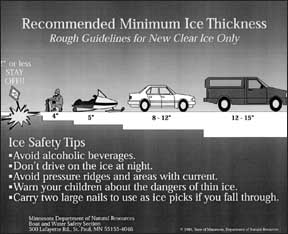DNR offers tips for ice safety
Some ice facts, according to the DNR, are:
 *New ice is usually stronger than old ice. Four inches of clear, new ice may support a person on foot while a foot of old, partially-thawed ice may not.
*New ice is usually stronger than old ice. Four inches of clear, new ice may support a person on foot while a foot of old, partially-thawed ice may not.
*Ice seldom freezes uniformly. It may be a foot thick in one spot and only a few inches thick just a few feet away.
*Ice formed over flowing water and currents is often dangerous. This is especially true near streams, bridges, and culverts.
*The insulating effect of snow slows down the freezing process. The extra weight of snow also reduces how much weight the ice can support.
The DNR recommends that people check the current temperature and conditions before going out on the ice and check locals for information about local conditions.
The DNR also recommends that people have a plan for what to do in an emergency, including carrying rope and ice picks.
For driving on ice, people should remember to stay off the ice at night (or at least drive very slowly in order to see any holes) and to be prepared to bail out in a hurry (including opening a window and removing your seatbelt).
If your car or truck plunges through the ice, the best time to escape is before it sinks, according to the DNR. The vehicle will stay afloat, for a few seconds to a few minutes, and the best escape is through the windows, since the doors may not open. If the windows are blocked, try to push the windshield or rear window out with your feet or your shoulder.
If you find yourself in the water, the DNR advises that you try not to panic. This may be easier if you have worked out a survival plan in advance, including:
*Don't remove your winter clothing, which can help you to float and can provide warmth.
*Turn toward the direction you came, since the strongest ice is most likely in that direction.
*Place your hands and arms on unbroken ice and try to pull yourself onto the ice. This is where a pair of ice picks comes in handy.
*Kick your legs to help pull yourself onto the ice. If a lot of water is trapped in your clothes, you may have to pull yourself out partially and then allow the water to drain.
*Lie flat on the ice once you are out to keep your weight spread out and roll away from the hole. This may help prevent breaking through the ice again.
*Get to a warm, dry shelter and rewarm yourself immediately. Seek medical attention for moderate to severe cases of hypothermia.
If someone else falls through the ice, call 9-1-1 for help. Then either yell verbal commands to them to get them to safety, reach a long item or throw rope to pull them to safety, or row a boat to them. Do not go out onto the ice and try to reach them unless all other options have failed.
Contact the author at editor@paynesvillepress.com • Return to Sports
Home | Marketplace | Community